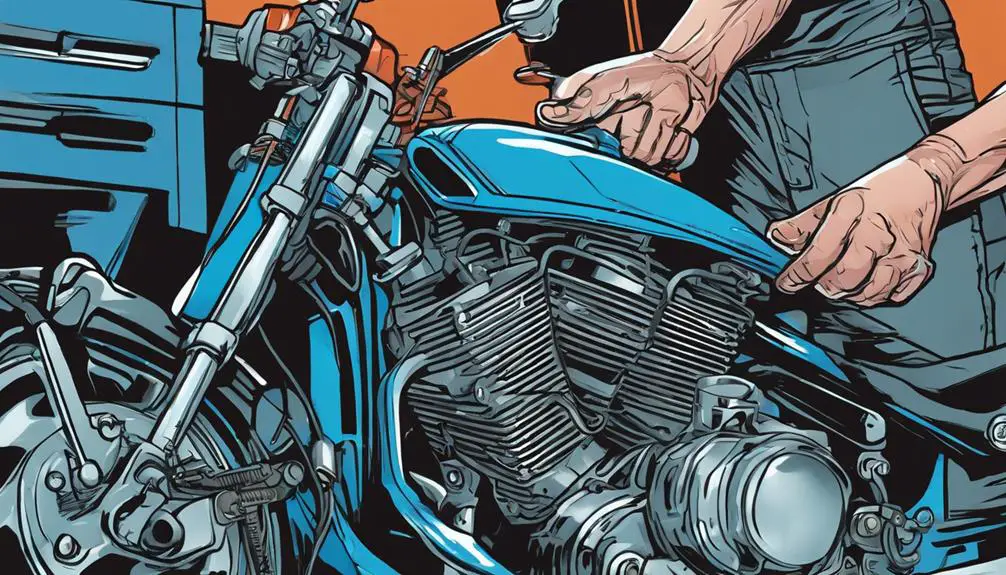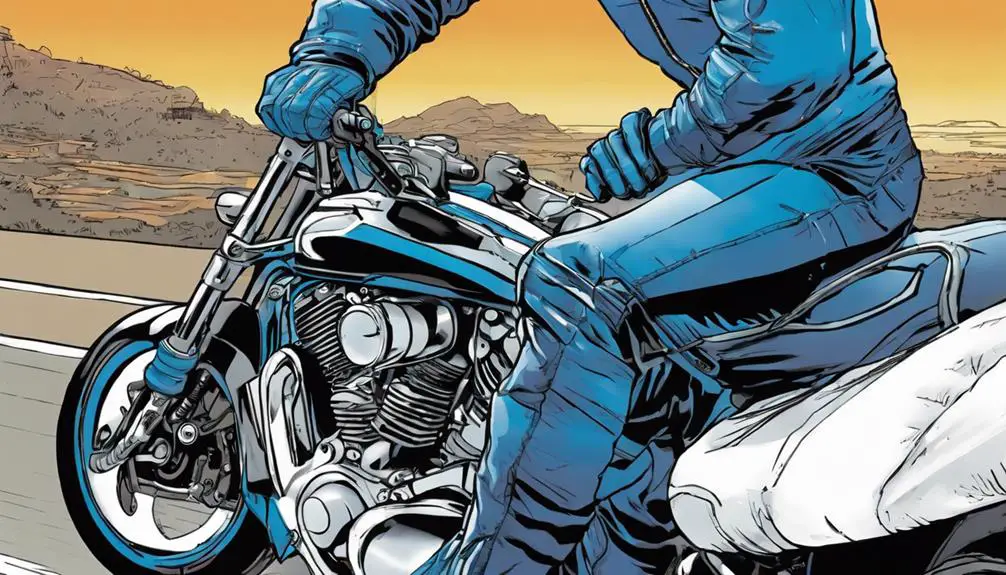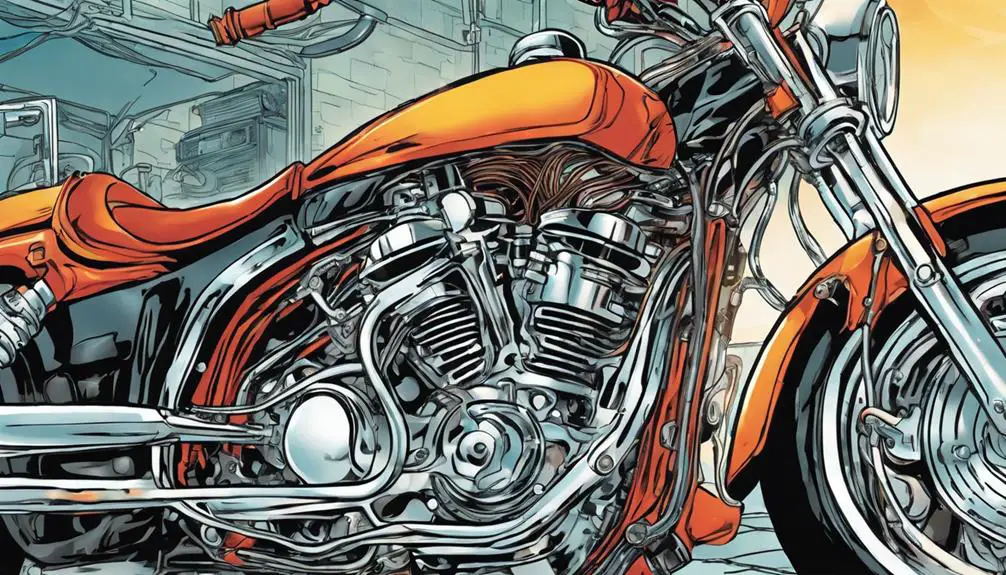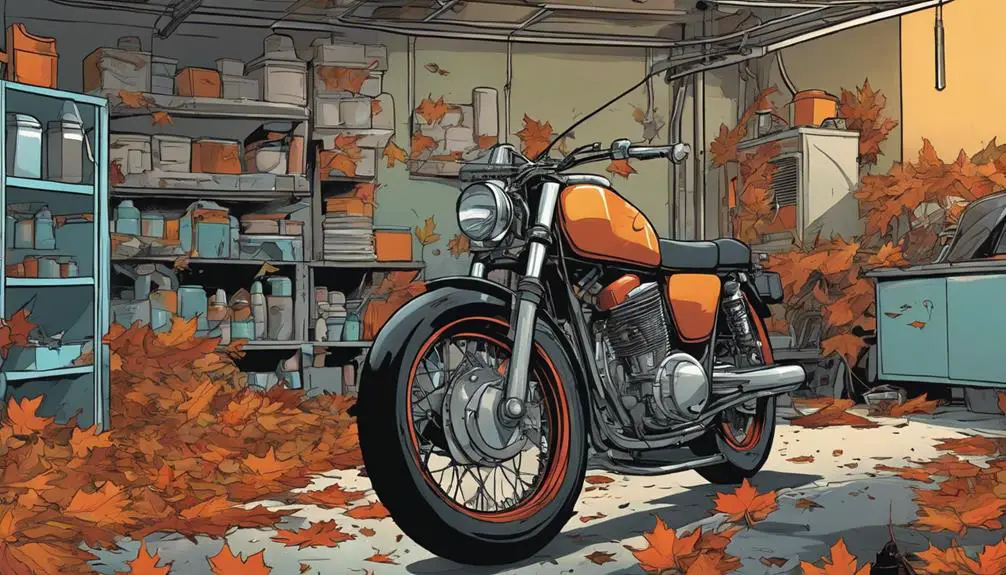Maintaining your motorcycle's coolant system is essential for peak performance and longevity. You should regularly check the coolant levels and verify they align with your manufacturer's specifications. It's also important to inspect for leaks and flush the system periodically. However, choosing the right coolant type and maintaining the correct mixture can be a bit tricky. Have you considered how these factors can impact your ride? Understanding the nuances of coolant care not only enhances your motorcycle's efficiency but also prevents costly repairs down the line. There's more to it than you might think.
Key Takeaways
- Regularly check coolant levels in the reservoir to prevent overheating and ensure proper engine performance.
- Choose the right coolant type based on your motorcycle manual and seasonal temperature variations.
- Inspect hoses and connections for leaks, wear, or damage to maintain effective coolant circulation.
- Flush the cooling system periodically to remove contaminants and replace old coolant with fresh fluid.
Importance of Coolant Maintenance

Maintaining your motorcycle's coolant is essential for preventing overheating and ensuring ideal engine performance. If you want to embrace the freedom of the open road, you can't ignore this significant aspect of your bike's upkeep. Coolant plays an important role in regulating your engine's temperature, keeping it running smoothly, and avoiding potential damage that could sideline your adventures.
When your coolant levels drop or it becomes contaminated, your engine's efficiency suffers. This could lead to overheating, decreased power, and even catastrophic engine failure. You wouldn't want to be stranded on a scenic ride due to neglecting something so critical, would you? Regular checks and maintenance of your coolant system empower you to stay in control and enjoy every mile without worry.
Additionally, maintaining your coolant helps maximize your motorcycle's lifespan. A well-cared-for engine translates into a more reliable ride, meaning less time in the garage and more time exploring the world around you.
Choosing the Right Coolant
When it comes to choosing the right coolant for your motorcycle, you'll want to understand the different types available and how they affect performance.
It's also essential to know the guidelines for mixing coolants and consider seasonal changes that might impact your choice.
Let's explore these important factors to keep your bike running smoothly.
Types of Motorcycle Coolants
Choosing the right coolant for your motorcycle is crucial for ideal engine performance and longevity. There are several types of motorcycle coolants available, each designed to meet different needs. The most common types are ethylene glycol-based coolants and propylene glycol-based coolants.
Ethylene glycol is popular for its excellent heat transfer properties and corrosion resistance, making it a reliable option for many riders. However, it's toxic, so you'll want to handle it with care.
On the other hand, propylene glycol is less harmful and biodegradable, which can be appealing if you're environmentally conscious. While it mightn't perform as well as ethylene glycol in extreme conditions, it's a safer alternative.
You'll also encounter premixed coolants, which save you the hassle of mixing and guarantee the correct ratio of coolant to water. If you prefer a DIY approach, concentrate coolants let you customize the mix according to your climate and riding style.
Ultimately, consider your motorcycle's specifications, your riding environment, and your personal values when selecting a coolant. Making an informed choice can keep your engine cool and running smoothly, allowing you to ride freely without worry.
Mixing Coolant Guidelines
Properly mixing coolant is essential to guarantee your motorcycle's engine receives the perfect protection it needs. To achieve this, start by checking your motorcycle's manual for the manufacturer's recommended coolant type. Different bikes require specific mixtures, so don't mix blindly.
When you've got the right coolant, make sure you're using the correct water as well. Distilled or deionized water is best, as it's free from minerals that can cause corrosion over time. Aim for a 50/50 mixture of coolant and water, which provides ideal freeze and boil protection.
When mixing, pour the coolant into the container first, then add water. This method helps prevent foaming and guarantees a better blend. Use a clean, dedicated container to avoid contamination from other substances.
After mixing, give it a good shake to combine thoroughly. Always label your mixture, so you know what you're working with later.
Seasonal Coolant Considerations
Understanding the seasonal changes in temperature can help you select the right coolant for your motorcycle, guaranteeing peak performance year-round.
Different temperatures require different coolant properties. For instance, when winter rolls in, you'll want a coolant with antifreeze capabilities to prevent freezing. In contrast, summer heat demands a coolant that can withstand higher temperatures without boiling over.
Consider these points when choosing your coolant:
- Temperature Range: Confirm the coolant matches the extremes you'll face.
- Coolant Type: Choose between ethylene glycol or propylene glycol based on your bike's needs and personal preference.
- Water Ratio: Remember, a proper mix of coolant and water enhances performance.
Checking Coolant Levels

To keep your motorcycle running smoothly, regularly check the coolant levels to guarantee they're within the recommended range.
It's a simple step that can prevent overheating and keep your ride liberating and exhilarating. Start by locating the coolant reservoir, typically marked with a fill line. Make sure your bike's engine is cool before diving in—safety first!
Once you've found the reservoir, visually inspect the coolant level. If it's below the minimum line, it's time to top it up. Use the manufacturer's specified coolant for peak performance. Remember, mixing different types can lead to unwanted reactions and compromise your bike's efficiency.
Don't forget to inspect for any leaks around the reservoir and hoses—if you spot any, address them immediately.
Keeping an eye on your coolant levels not only enhances your bike's performance but also empowers you as a rider. You're taking charge of your machine, ensuring it's always ready to take you on your next adventure.
Flushing the Cooling System
Flushing the cooling system is essential for removing contaminants and ensuring your motorcycle runs at ideal temperatures.
Over time, dirt, debris, and old coolant can build up, leading to overheating and engine damage. By regularly flushing your system, you liberate your bike from these impurities and keep it performing like a dream.
Here's a quick checklist to guide you through the process:
- Choose the Right Coolant: Make sure you're using a high-quality coolant that's compatible with your motorcycle.
- Gather Your Tools: You'll need a drain pan, a funnel, and possibly a hose for rinsing.
- Follow Manufacturer Guidelines: Each bike has specific recommendations, so consult your manual for the best practices.
Inspecting Hoses and Connections

Regularly inspecting hoses and connections is vital for maintaining your motorcycle's cooling system and preventing leaks or failures. Start by looking for any signs of wear, such as cracks, fraying, or stiffness in the hoses. These issues can lead to serious problems if left unchecked.
Make certain to check the clamps and connections, too; they should be tight and secure. Loose connections can disrupt coolant flow and cause overheating.
Don't forget to examine the routing of the hoses. Confirm they're not rubbing against sharp edges or hot components, as this can lead to premature failure. If you find any damaged hoses, it's imperative to replace them immediately. You want your ride to be free and unencumbered, not held back by faulty components.
Also, check for any signs of corrosion on metal connections. A little rust can weaken the integrity of your system.
Identifying Coolant Leaks
After ensuring your hoses and connections are in good shape, the next step is to identify any coolant leaks that could compromise your motorcycle's performance.
Detecting coolant leaks isn't just about maintaining your ride; it's about freedom on the road without the worry of overheating.
To spot a leak, keep an eye out for these signs:
- Puddles on the Ground: A telltale sign under your bike can indicate where coolant's escaping.
- Low Coolant Levels: Regularly check your reservoir; if it's dropping faster than usual, you might have a leak.
- Overheating Engine: If your temp gauge is climbing, it could mean coolant's not circulating properly.
If you spot any of these signs, act quickly. Ignoring a leak can lead to serious engine damage and a loss of that liberating feeling you crave.
Your motorcycle deserves attention, so stay aware and keep it running smooth.
Seasonal Coolant Changes

Changing your coolant seasonally is essential for keeping your motorcycle running smoothly.
You'll want to stick to recommended change intervals to avoid overheating and engine damage.
Plus, knowing the signs of coolant deterioration can save you from costly repairs down the line.
Importance of Seasonal Changes
Seasonal coolant changes are essential for maintaining your motorcycle's performance and preventing engine damage. As temperatures shift, the demands on your cooling system change, which means you need to adapt your coolant to suit the conditions. Neglecting this simple maintenance can lead to overheating or freeze damage, costing you time and freedom on the road.
Here's why you shouldn't overlook seasonal changes:
- Temperature Resilience: Different coolants perform better in varying temperatures. Adjusting for seasonal extremes keeps your engine cool when it's hot and protected when it's cold.
- Corrosion Protection: Seasonal changes help guarantee that your coolant's corrosion inhibitors remain effective, which keeps your engine components safe from rust and deterioration.
- Optimal Performance: Fresh coolant enhances the efficiency of your cooling system, allowing your bike to run smoother and respond better to your commands.
Recommended Change Intervals
To keep your motorcycle running smoothly, you should aim to change the coolant at least twice a year, ideally with the changing of the seasons.
As you embrace the freedom of the open road, don't let neglect hold you back. Spring and fall are perfect times for this essential maintenance, guaranteeing your bike can handle the temperature shifts without a hitch.
During spring, as the days grow warmer, it's crucial to refresh your coolant. This not only helps your engine run cooler but also prepares it for the heat of summer rides.
Similarly, in the fall, as temperatures dip, changing the coolant again guarantees your bike stays protected against freezing conditions.
Signs of Deterioration
Recognizing the signs of coolant deterioration can save you from costly engine damage and keep your motorcycle running efficiently. Seasonal coolant changes are essential, especially when temperatures shift dramatically. Here are some signs to keep an eye out for:
- Discoloration: If your coolant has turned brown or murky, it's lost its effectiveness.
- Sediment: Noticeable particles or sludge in the coolant indicate contamination.
- Sweet Smell: A sweet odor often signals a coolant leak, which can lead to overheating.
Professional Maintenance Tips
When it comes to coolant maintenance, having a professional inspect your motorcycle guarantees peak performance and longevity. These experts can spot issues that might slip by you, ensuring your bike runs smoothly and efficiently.
Regular checks by a mechanic can help you dodge costly repairs down the road and keep your ride feeling liberated. During a professional maintenance session, they'll not only check your coolant levels but also examine the entire cooling system for leaks or blockages.
They'll flush the system if necessary, replacing old coolant with fresh fluid that enhances heat transfer and prevents corrosion. This proactive approach helps maintain your motorcycle's health and keeps you on the road, enjoying the freedom of the ride.
Don't underestimate the importance of professional maintenance; it's an investment in your motorcycle's future. You'll feel empowered knowing that trained eyes are keeping your bike in top shape.
Frequently Asked Questions
Can I Mix Different Brands of Coolant?
You might think mixing different brands of coolant is okay, but it can lead to problems.
Each brand may use different chemicals that don't always get along. When you mix them, you risk compromising the coolant's effectiveness, which can lead to overheating or corrosion in your system.
To keep everything running smoothly, it's best to stick with one brand and type. Your ride deserves the best, so don't take any chances!
How Often Should I Check My Coolant Levels?
Checking coolant levels consistently creates a confident, carefree ride.
You should inspect your coolant at least once a month or before long trips. This helps guarantee your engine runs smoothly and prevents overheating.
Don't forget to look for leaks or discolored fluid, as these could indicate bigger problems.
Staying proactive about your coolant means you'll enjoy freedom on the road, knowing your ride's in great shape.
What Color Should My Coolant Be?
When you check your coolant, its color can tell you a lot about its condition.
Typically, coolant should be bright green, orange, or pink, depending on the type. If you see a rusty brown or murky color, it's a sign something's wrong.
You need to act quickly to avoid potential damage. Regularly monitoring and understanding your coolant's color empowers you to keep your engine running smoothly and efficiently.
Don't overlook this essential step!
Are There Any Signs of Coolant Degradation?
Absolutely, there are signs of coolant degradation you should watch for.
Look for a change in color, often turning brown or rusty, which indicates contamination.
You might also notice a sweet smell or residue around the reservoir.
If your engine runs hotter than usual or you see steam rising, that's a red flag.
Don't ignore these signals—your ride deserves the freedom of a well-maintained cooling system to keep going strong!
Can Coolant Affect My Motorcycle's Performance?
Have you ever felt your engine's roar diminish, like a lion's growl fading into a whisper?
Coolant plays an essential role in your motorcycle's performance. If it's degraded or low, your engine can overheat, leading to reduced efficiency and potential damage.
You might notice sluggish acceleration or odd noises as a result.
Keeping your coolant in check isn't just maintenance; it's about releasing your ride's full potential and enjoying the freedom of the open road.
Conclusion
By prioritizing coolant care, you can greatly enhance your motorcycle's performance and lifespan.
For instance, a rider who regularly checks and flushes their coolant noticed a 15% improvement in engine efficiency, leading to smoother rides and better fuel economy.
Don't underestimate the importance of maintaining proper coolant levels and quality.
Regular upkeep not only prevents overheating but also guarantees your bike runs at its best, making every ride enjoyable and worry-free.